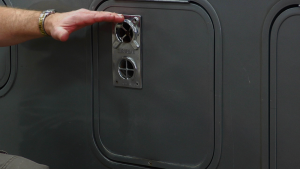

During those winter months, your RV furnace can be an absolute godsend. Not only does it keep you and your fellow travelers comfortable, but it can mean the difference between an enjoyable RV adventure and one that’s miserably cold.
Today, we’re going to provide you with our top RV furnace troubleshooting tips, as well as advice about installation and parts. Let’s get started!
RV Furnace Parts
Just like a normal furnace, there are many important parts to an RV furnace. We’ve discussed some of these in more detail below.
Thermostat
Your RV furnace thermostat is the main control point that determines when and how much heat will be delivered by the furnace. It lets you set the temperature of your furnace, as well as adjust it.
Furnace Access Door
Keep your RV furnace looking nice and neat by including a furnace access door in your set-up. These are particularly popular for RV furnace brands such as Atwood and Suburban.
RV Furnace Vent
RV furnace vents (especially adjustable ones) allow you to customize how much air flow comes out of your furnace. They also provide additional safety by acting as a barrier between you and the source of heating; a must-have if you travel with small children or pets.
Furnace Motor
Just like a car, the furnace motor is what keeps your system running. Without it, your system won’t work properly, nor will you be able to heat your RV. Therefore, it’s important that your motor is always in top shape.
You can buy all of these parts through your local RV furnace or accessories store, as well as on websites such as Amazon.
RV Furnace Installation
Many RV owners choose to install their furnace themselves, while others choose to hire a professional to do the work for them. Keep in mind that that RV furnace installation does involve working with gas, something no one should attempt unless they are highly experienced in or knowledgeable about.
When purchasing your RV furnace, the first thing to do is to ensure it is compliant with your model of RV. Will it fit the allocated space? Make sure you’ve measured this area more than once to be on the safe side.
If choosing to install the furnace yourself, the product’s manual may come with installation instructions, or you can also find a wide range of video tutorials online to assist you.
RV Furnace Troubleshooting
Need some RV furnace troubleshooting tips? We’ve listed the most common problems people have experienced with their furnace, as well as our advice to help you solve these issues yourself.
Your furnace turns on, but there’s no heat
The first thing to do is check if the propane is turned on. If it is, then your RV furnace may be experiencing insufficient air flow through the furnace, a bad propane valve at the furnace, or a bad regulator at the propane tank. Assess your furnace to ensure there aren’t any blockages. If the problem persists, seek the services of an RV furnace repair company.
There is a bad smell when you turn your furnace on
If your furnace hasn’t been switched on for quite some time, then this is to blame for the smell. Allow the furnace to run for a little while and you should soon notice that the smell disappears. If the furnace is still emitting a bad smell after this time, turn it off and ensure there isn’t a propane leak. Seek professional help before switching it on again.
The pilot light won’t stay lit
Depending on your model of furnace, you may have a pilot light. Modern RV furnaces have a direct spark ignition system that replaces a pilot light. If your pilot light won’t light or stay lit, then first ensure the thermocouple is positioned properly in the pilot flame.
This problem may also be caused by a bad regulator at the propane tank. If this is the case, then you might notice the flames on your stove burners have excessive yellow in them when on (as opposed to mostly being blue). If this is the case, then it’s best to call up your local RV furnace specialist.
There’s soot on the exhaust vent
First, check all of the vents in your RV. There shouldn’t be signs of soot on your exhaust vent, so this may be telling you there’s improper combustion, which is leaving unburned fuel as it is venting. Again, seek the service of an RV furnace specialist before continuing to use your heating.
There you have it – our RV furnace troubleshooting guide, including information regarding parts and installation. Your RV furnace is an excellent addition to your trailer, so it’s certainly something you’ll want to take good care of.
